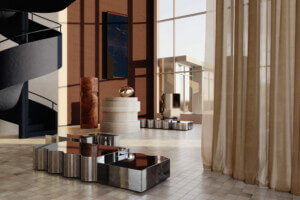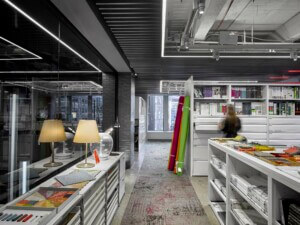/imagine: A Journey into The New Virtual
MAK Exhibition Hall
Vienna
Once upon a time the internet was young and so were we. It was open, not yet shaped by the horrors of techno-capitalism (and so were we). The internet was a space not only of communication but of media speculation. It extended Marshall McLuhan’s thoughts on TV and radio in which he suggested a relationship between the human body and the global mediatized world—radio extends your hearing, TV extends your vision, and so on. “Digitalness” extended McLuhan’s idea of media as space and/or body. This was a new form of media that offered other kinds of connection and transformation, other ways of altering our bodies’ relationship to each other and the world.
These ideas were both radical—think cyborgs and cyberpunks—and mainstream—see, for example, Microsoft’s 1994 ad campaign, “Where do you want to go today?” At this point, the internet promised new possibilities, new ways of defining space, new ways of forming identity, even new ways of being human. The ugly phrases used to articulate the world as we knew it and the world as it might become: meat space and cyberspace.
This all seems a long time ago and, with hindsight, naive and over optimistic. Today the internet has become just a few websites and a billion largely unvisited corporate brochures. Email and messaging are a grind, not liberation. And the only widespread effect on identity has been to amplify tedious yet frightening so-called arguments.

/imagine: A Journey into The New Virtual, curated by Marlies Wirth and Bika Rebek, felt like the kind of conversation we used to have about digitality. Its premise is that digitalness can transform experience, culture, and identity. The curators laid out their argument in four chapters: Speculative Narratives and Worldbuilding, Research Investigations, Dreamscapes, and AI and Algorithmic Variation. These titles point to the difficulty of trying to capture such a mercurial subject, and, as the curators write, the show’s approach is freeze-frame rather than exhaustive.
The show reminded us that even though those strange questions about bodies and space are were asked long ago, digital life remains unexamined, even as we are engulfed in it. The who, what, where, how, and—most evasively—why are glossed over like a frictionless swipe on an oleophobic fluoropolymer coated alkali-aluminosilicate glass screen.
Virtual space, such as it is manufactured in games and the metaverse, is just an approximation of meatspace. It serves us perspectivally rendered images of the world as we have come to understand it: immaterial replicas of the material world. The assumed universality of space—something reduced to dimensions—ignores other realities. Space is different depending on who you are, where you are. It is constructed through gender, race, age, and so on. Space is contingent, defined as much by the possibilities of occupation as by metrics. Space, in other words, is ideological. The point underscores the full banal horror of the metaverse’s proposition of a corporate lobby extended to infinity, an eternity of executive lounges, with no escape from the virtual doppelgänger of late-capitalist reality.
/imagine was installed in a large airy space at the MAK, Vienna, an applied arts museum founded in response to industrialization in the 19th century. It feels very physical, very unvirtual. The installations themselves often defined the exhibition space as large models, pieces of furniture, spatial installations. There were also screens, desks with keyboards, black boxes with big projections. Big 2D bubbles hung in the space as section titles, as if escaped from an app. The virtual, the exhibition seems to say, is something that oscillates between screen-worlds, object-hood, and spatial experience.
The show began with Liam Young’s neo–sci-fi film Planet City, which visualizes a city in the year 2050 where “the Earth’s entire population lives together in a single city, while the rest of the planet’s surface is surrendered to a global wilderness for regeneration.” (NEOM founding-pitch vibes, anyone?) It’s impressive in its slick production, yet it’s also a case in point for the contemporary problem of “the future.” We live after Blade Runner—the original film was set in November 2019—and the reality of our future is both more banal and perhaps more weird, alienating, or laden with crisis.

Planet City’s evident nostalgia for the signs and symbols of the future might signal the impossibility of our imagining futures as easily as the Baby Boomers did. What does it mean to traffic in familiar sci-fi tropes? Has the future changed, or have we? Maybe the aesthetic project of postwar sci-fi is outdated to the extent that it is now sanitized: Movements like neotrad and normcore—aesthetic regimes that directly reject futurist expression—may really contain the harbingers of worlds to come. The future just isn’t what it used to be.
A series of AI image–generation experiments attempt to find ways of looking through the digital itself. Lee Pivnik’s Symbiotic House uses Midjourney to synthesize community participation, and show how outsourcing of authorship can open up forms of open collaboration. Leah Wulfman’s My Midjourney Trash Pile imagines buildings formed from waste material—a form of extreme recycling. To make things physical, these digital images have been painted by artists in a Chinese oil-painting factory. These are places where the recycling of the imagery that defines global media culture and the intrinsic operation of digital files meets handicraft and individual skill.
Questions of material and value are key to Kordae Jatafa Henry’s Earth Mother, Sky Father, a film set in an abandoned mine in Congo, a site where workers in inhumane conditions extract the rare earth materials that go into high-tech electronic devices. Henry imagines alternative economic systems where value is retained locally and suggests how that might enrich a community’s custom. The piece is about how the materiality of the digital might also intersect with the myths and rituals we use to understand ourselves.
Other works dealt with the questions of imaging and vision through the digital itself. Andrés Reisinger’s Hortensia, for example, started life as an image of a chair made from a cloud of hydrangea petals, posted to Instagram. It’s an image so light in its digital delicacy that seems impossible to create in our physical world. The image then was minted as an NFT (remember them?) and, through collaboration with textile designer Júlia Esqué and manufacturer Moooi, eventually became a “real” thing, albeit a physically strange one. There’s something Joseph Kosuth–like about it, as it reminds me of One and Three Chairs, which showed a chair three ways: as a real chair, as photo, and as text description. Hortensia also seems to ask questions about what or which is “real.” Is our world a model of the digital as much as the digital a model of ours?

Other works took us into the digital itself to then look back at the world. Simone C. Niquille’s HOMESCHOOL is narrated by a domestic robot apparently learning to navigate and comprehend a home at Tom and Jerry skirting-board height. Both childlike and sinister, we follow its readings and misreadings of its machine vision and its low-grade intelligence where, for example, a gun registers as interchangeable with a toothbrush. The human logics of domestic space and the logistics of digital space collide, producing fragmentation, wrongness, and glitches.

Space Popular stages a virtual-reality lecture/puppet show. When you take your seat at a huge round table–slash–infographic, it merges with the virtual space that appears when you put on your headset. The format feels fresh and simple. On one hand it’s a traditional narrated talk, and you’re cast as the audience looking towards a stage. On the other, it’s a kind of edu-tainment spectacular where objects, film clips, and text pop up then disappear in a puff of motion graphics. The show’s portals take us through a chronology of fictional portals—from Alice’s rabbit hole, the wardrobe/gateway to Narnia, Doc Brown’s DeLorean from Back to the Future—and argue that fiction holds the best precedents for the architecture of digital space.
/imagine’s freeze frame was one that positions design as something between the physical and digital. Design itself, the show wagered, is a conduit that connects alternative understandings of physical, conceptual, and organizational aspects of our world. Morehshin Allahyari’s Material Speculation: ISIS articulates the questions we face about what digitized worlds might become. Her digitally reconstructed and 3D printed objects are models of artifacts destroyed by ISIS. Inside each is a USB stick containing information about the original object. Explicit violence, politics, ideology, the past, knowledge, colonialism, universality and uniqueness, the original and the copy, the material and the immaterial—these topics are embedded in these objects which are at once recreations of the past and possibilities for the future.

The show reopened ways (portals, even) to consider the consequences and meanings of the digital outside of the sterile, corporatized walled gardens we now spend our digital lives within. It reexamined those early exciting potentials that the first digital age displayed. It isn’t concerned with the complex geometries of computing power, prioritizing instead questions about culture, environment, and politics in the postdigital world.
Those early distinctions between meat and cyber spaces are now redundant. Traditional boundaries and categories have collapsed, and the virtual is enmeshed in the banalities of our everyday lives. /imagine is a prompt—it’s literally the Midjourney command line—that asks us to look again, to try to find the texture, shape, and nature of the digital as it exists today.
Sam Jacob is director of Sam Jacob Studio for architecture and design in London and is a professor at the Angewandte, Vienna.











